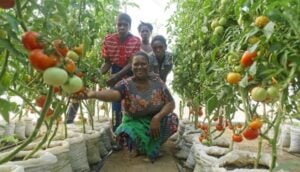Prices are the sharp end of a long stick.
Gas prices. Food prices. Inflationary prices. Downward price pressure. Upward price pressure. Global supply chains. On and on it goes, with each new headline revealing a business environment stripped of its old rhythm. The environment feels particularly chaotic for any business dependent on functioning supply chains (i.e., virtually all of them).
Supply chains center on commodities, and commodity markets no longer run ‘business as usual’. Operating on supply and demand, the validity of these markets rely on the assumption Adam Smith’s ‘invisible hand’ will lead to equilibrium— where prices generally remain smooth. Given the last few years, it’s clear this invisible hand may have inoperable carpal tunnel.
Smith’s theory was always stacked against producers, particularly those in tropical value chains like coffee and cocoa. Despite undertaking the highly skilled, challenging work of supplying some of the world’s most beloved goods, they suffer from systemic poverty caused by imbalanced markets. This includes trading prices that never adjust for inflation and remain forever fixed in nominal terms. Farmers have been subject to market prices decoupled from production realities for decades, subsidizing the world’s coffee and cocoa habits for at least six years. With equilibrium further undermined by pushes towards higher productivity, the environmental and social consequences have rippled effects including child labor and deforestation. Farmers know the solution is the one thing corporate buyers have been unwilling to consider… until now.
Given companies are getting a taste of cost increases, production delays, and labor shortages—all of which show no signs of slowing—it’s time to look beyond the commodity market as the end-all-be-all of price discovery. Its volatile new normal creates the illusion of powerlessness, but there are ways of controlling what seems to be out of our hands, the most obvious of which just might save entire industries while ending poverty for billions.
The solution? Saying screw market prices du jour, instead screwing prices to something more stable and mutually beneficial: producers’ living incomes.
It means generating much-desired equilibrium by embracing price stability. Procurement must be radically transformed, with companies building future-thinking sourcing strategies anchored to livelihood needs at origin.
Rather than ever-changing valuations, a foundation should factor in what’s required for production, including sustainable cultivation, withstanding shocks, and viable returns. In essence, living income-based contract prices should be the bare minimum, but a consistent minimum. If lesser prices mean farmers aren’t able to grow the product, let alone support their families, then those prices should be called what they are— exploitation. Such a baseline for price discovery makes irrelevant those chronic market fluctuations that send everyone into a tizzy. It sets up everyone for a win-win-win, that elusive triple bottom line so many claim, but almost no one actually achieves.
These are the top three reasons why this kind of approach is a game changer:
- Supply Stability
We are all familiar with the perils of supply shocks. When COVID-19 laid bare the toll of being an essential worker comparable to compensation, a labor scarcity ensued. An ongoing fertilizer crisis forced farmers to scale back on cultivation, boding a food shortage.
There is no shortage of threats to producers’ ability to keep supplying what our world needs. When expense outpaces compensation, there’s little option but to eventually walk away. Agriculture needs to be profitable. When it fails to be a decent livelihood source, a supply dearth follows, and companies must compete for a limited pool of raw materials. Without a plan to share risk as well as reward, producers’ challenges will become corporate crosses to bear.
This is preventable, both by entire industries and individual businesses. With long-game thinking and strategic resource allocation, sustained production can easily be incentivized. All it takes is committing to a stable, viable price point that facilitates future-proofed farming, the first step in supply chain stability.
- Cost of Goods Control
Erratic prices create a myriad of problems. Budgets are impossible to manage, financial projections become a guessing game, new initiatives are backburned until things ‘level out.’ Customers become negatively and irreparably impacted.
Companies anticipate some commodity market fluctuations and account for them in their cost of goods. However, the not-so-distant future doesn’t look so corporate-skewed. Climate change, supply deficits, labor scarcities, etc. will keep driving commodity prices up. It’s going to be a roller coaster that continues to send unforeseen shock waves.
Just like consistent, stable prices allow producers to plan ahead, make necessary improvements and above all keep producing, it’s similarly a corporate interest. No volatility. No scrambling. No checking the commodities markets multiple times a day because the insanity happening there is irrelevant to your cost of goods. That kind of visibility and control is an invaluable financial management tool, especially in an unpredictable price world.
- Marketing Authenticity
Everybody’s trying to claim their share of the sustainability pie, with rhetoric often outpacing impact. With Sustainability and Procurement departments operating in isolation from one another, there’s discrepancy between do-good projects and actual operations. While socio-economic and environmental programs allow companies to say things like ‘ethically traded’ and ‘sustainably sourced,’ they invariably miss the biggest and most important puzzle piece — how much people are paid for their products. If producers aren’t compensated equitably, the product isn’t ethical or sustainable. End of story.
Consumers are wising up to toothless claims, requiring specifics and clear reference points. Living Wages and Living Incomes have become indicators of authenticity and a prerequisite for brand trust. With greenwashing bubbles about to burst, dialing in a mutually reinforcing producer remuneration strategy is like branding bubble wrap. Starting with real action rather than communications spin creates the kind of meaningful and engaging brand narratives everyone’s after, driving brand loyalty.
While future-proofing supply chains with stable, producer-focused pricing certainly isn’t status quo, it’s not impossible. There are various ways to commit to equitable, long-term pricing commitments for key commodities, exemplified by proof-of-concept companies. Some, like Ben and Jerry’s and Tony’s Chocolonely add a Living Income differential to market-based contracts. Diaspora Co. pays farmers an average 6x premium to facilitate living wages.
Other approaches completely break from the market, creating sourcing methods that shore up supply chains while driving living incomes across the supply chain. To ensure sustainable sourcing claims included economic sustainability at origin, Heifer International developed the Living Income Pricing methodology, piloted with Sustainable Harvest and Bellwether, to determine equitable price points specific to individual supply flows.
Coffee newcomer Torque attaches retail value to raw material value, reverse engineering the value chain with what they call Proportional Pricing. This model guarantees producers are pre-paid 20% of the consumer price, the same percentage as Torque’s profit margin.
Nanelle Newbom, co-founder of Torque Coffee, says “It’s a new kind of price stability. Whatever the bag of coffee is going for on the shelf determines the price of green coffee to farmer and it just so happens the price of a retail bag of coffee is pretty stable… It’s about just treating everyone like an adult and paying a cut from the full value.” Reciprocally, farmers Torque sources from know exactly how much they’ll be paid, allowing for necessary farm planning while earning loyalty. Such balanced value distribution ensures financial viability and inclusivity at origin. Edwin Martinez, owner of Finca Vista Hermosa coffee farm in Guatemala, and founder of ONYX Coffee importers explains, “A coffee farmer having a future depends on having a voice and connecting to the coffee consumer. For a coffee farmer to participate in a small way at retail level gives something tangible to build a future on. That’s why as farmers and importers we are so excited about the impact of tying the farmer’s green coffee price to the roaster’s retail price.”
Such initiatives are undertaken not just because they are the right thing to do, but because they are forward-thinking and business-savvy. Without companies embracing innovative changes, the last few years of disruption will only tease what’s to come. It’s worth the investment now. Done with the right framework, focusing on farmers can be a relatively simple, transparent and valuable solution, bringing equilibrium without relying on an unreliable, invisible hand.










